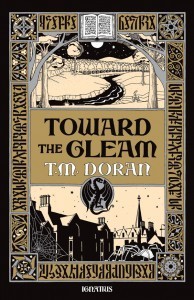"Toward the Gleam": Making the Sausage
by T.M. Doran | IPNovels.com
I’ve been asked by many how this story came to be. Where did the idea originate? How was the “superstructure” of the story assembled? How long did it take to compose Toward the Gleam?
These questions are asked of many authors about many novels. Some story writing happens so organically that only in retrospect can the experience be described, because it is far more than just work products and dates.
 Some aren’t interested in how the sausage is made, or would rather not know, but for those intrigued by such things, here is the backstory—to the best of my recollection. The short answer I’ve given in interviews and in response to readers’ questions: Toward the Gleam took 20-30 years to compose. In fact, research began long before the idea for the story was conceived, in the sense that the story feeds on paleohistory, the ideologies and emerging science of the 20th century, and 20th century historical characters. Going back to the 1970s, I had a keen interest in these subjects and sought books and articles on philosophical, historical (including paleohistorical), and scientific topics, as well as biographies of remarkable men and women. Some of these works, such as Peter Kreeft’s The Philosophy of Tolkien combined biography and an intense exploration of ideas. Others, such as Martin Gilbert’s biography of Churchill, provided deep insight into their subject. The documentary and literary works of these historical characters themselves, such as Churchill’s A History of the English Speaking Peoples, Chestertons’s The Everlasting Man and Fr. Brown stories, allowed me to hear their ideas and beliefs, along with stylistic nuances, in their own literary voices. Even though only snippets were incorporated into Toward the Gleam, the insight and detail these resources provided made me comfortable—If such a word can be used—transplanting some of the “DNA” of these historical characters into my own characters.
Some aren’t interested in how the sausage is made, or would rather not know, but for those intrigued by such things, here is the backstory—to the best of my recollection. The short answer I’ve given in interviews and in response to readers’ questions: Toward the Gleam took 20-30 years to compose. In fact, research began long before the idea for the story was conceived, in the sense that the story feeds on paleohistory, the ideologies and emerging science of the 20th century, and 20th century historical characters. Going back to the 1970s, I had a keen interest in these subjects and sought books and articles on philosophical, historical (including paleohistorical), and scientific topics, as well as biographies of remarkable men and women. Some of these works, such as Peter Kreeft’s The Philosophy of Tolkien combined biography and an intense exploration of ideas. Others, such as Martin Gilbert’s biography of Churchill, provided deep insight into their subject. The documentary and literary works of these historical characters themselves, such as Churchill’s A History of the English Speaking Peoples, Chestertons’s The Everlasting Man and Fr. Brown stories, allowed me to hear their ideas and beliefs, along with stylistic nuances, in their own literary voices. Even though only snippets were incorporated into Toward the Gleam, the insight and detail these resources provided made me comfortable—If such a word can be used—transplanting some of the “DNA” of these historical characters into my own characters.
In the case of the philosophical questions, I frequently referred to my 4-volume Encyclopedia of Philosophy (not to be tackled after a glass of wine), and to the encyclicals and letters of St. John Paul II. A keen interest in the compatibility and intersection of science and philosophy drew me to Kurt Gödel, Einstein, and Ludwig Wittgenstein. Intellectual struggles abounded; for example, trying to wrap my mind around phenomenology, Gödel’s incompleteness theorem, and Owen Barfield’s concepts of consciousness.
First names and aliases were adopted for the veiled historical characters, not for legal reasons as some have surmised, but to keep some “space” between the historical characters and my own literary characters, to allow me to take these characters places—geographically, behaviorally, psychologically—that differ from the actual historical characters. A prominent example of this “space” is the Stockholm chapter featuring John Hill and Greta Erickson.
I have been reading—and enjoying—mystery stories for decades, and it made sense to re-examine A. C. Doyle, Agatha Christie, and J. D. Carr in regard to the mystery and suspense elements of the story. I love a good mystery and have tried my hand at dozens of short stories (for those interested, you can find “The Deadly Dart Mystery” in an appendix to Terrapin, and “A Legendary Mystery” and “The Yellow Tavern Mystery” on the Ignatius Press site). T” contains two such puzzle plots: the mystery of Sir Richard Hope’s disappearance that Gilbert solves in the September 14, 1931 chapter (a la Fr. Brown), and the puzzle of the vanishing treasures.
I don’t remember the exact day or year of the “Aha” moment, when the foundational idea for the story came to me, but it was around the year 2000, while I was taking a walk. Although I was invigorated by the idea, I was also intimidated by the effort and research that would be necessary to pull off such an audacious concept.
Carl E. Olson's Blog
- Carl E. Olson's profile
- 20 followers



